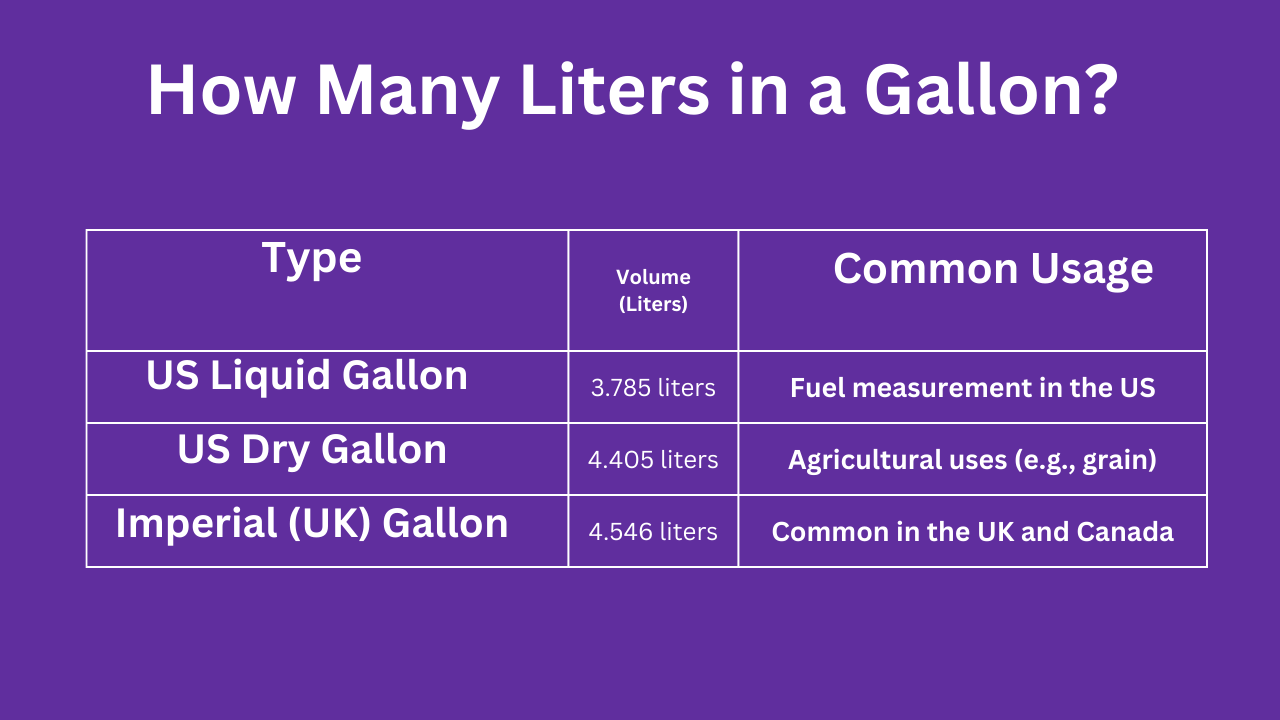Understanding how many liters are in a gallon is essential for anyone navigating the world of recipes, international travel, or even science class. Whether you’re a student tackling a homework assignment, a home cook working with a recipe written in imperial measurements, or a traveler figuring out gas prices abroad, knowing how to convert gallons to liters (and vice versa) can be incredibly useful.
This guide will break down the topic step by step, clarify the differences between various types of gallons, and provide you with practical tools to make conversions easy and quick.
What Is a Gallon? Understanding the Basics
While the gallon is a common unit of measurement in the United States and some other countries, it’s important to note that not all gallons are created equal. There are three primary types of gallons used internationally, each with its own specific volume.
Types of Gallons
| Type | Volume (Liters) | Common Usage |
|---|---|---|
| US Liquid Gallon | 3.785 liters | Fuel measurement in the US |
| US Dry Gallon | 4.405 liters | Agricultural uses (e.g., grain) |
| Imperial (UK) Gallon | 4.546 liters | Common in the UK and Canada |
Why Are There Different Types of Gallons?
The variation in gallon measurements can be traced back to historical developments. The US gallon is based on the Queen Anne wine gallon (defined in 1706). On the other hand, the Imperial gallon was standardized in 1824 to align measurements across the British Empire. The US dry gallon, while less commonly used, ties back to grain measurements.
What Is a Liter?
While gallons are part of the imperial and US customary measurement systems, the liter is a metric unit of volume. It’s the standard unit in the metric system and is widely used across the globe for measuring liquid and dry volumes. One liter is equivalent to 1 cubic decimeter (dm³).
Key Facts About Liters
- 1 liter equals 1,000 milliliters (ml).
- The metric system uses liters for everything from beverages to scientific experiments.
- Liters are highly precise, making them ideal for global standardization.
How Many Liters in a Gallon? The Exact Conversion Formula
To convert gallons to liters, simply multiply the number of gallons by the respective conversion factor for that type of gallon.
Conversion Factors for Each Gallon Type
- US Liquid Gallon: 1 gallon = 3.785 liters
- US Dry Gallon: 1 gallon = 4.405 liters
- Imperial Gallon: 1 gallon = 4.546 liters
Here’s the conversion formula you can use for all types:
Liters = Gallons × Conversion Factor
Example Conversions
- US Liquid Gallon Example
-
-
- If you have 5 US liquid gallons, multiply by the conversion factor of 3.785.
- 5 × 3.785 = 18.925 liters
-
- Imperial Gallon Example
-
-
- If you have 2 Imperial gallons, multiply by the conversion factor of 4.546.
- 2 × 4.546 = 9.092 liters
-
Step-by-Step Guide to Converting Gallons to Liters
Step 1: Identify the Type of Gallon
Determine whether you’re working with a US liquid gallon, US dry gallon, or Imperial gallon.
Step 2: Use the Correct Conversion Factor
Refer to the conversion factor for your gallon type.
Step 3: Multiply by the Conversion Factor
Multiply the number of gallons you have by the conversion factor to calculate the volume in liters.
Here’s a quick reference table to make conversions even easier.
| Gallons | US Liquid Gallon (Liters) | US Dry Gallon (Liters) | Imperial Gallon (Liters) |
|---|---|---|---|
| 1 gallon | 3.785 liters | 4.405 liters | 4.546 liters |
| 5 gallons | 18.925 liters | 22.025 liters | 22.730 liters |
| 10 gallons | 37.850 liters | 44.050 liters | 45.460 liters |
Bonus Tip
If you need a quick on-the-go solution, you can always use online tools like Google’s gallon-to-liter converter or a smartphone app for unit conversions.
Real-World Examples of Gallon-to-Liter Conversions
1. Fueling Up Abroad
If you’re driving in Canada and you see gas priced per liter, you’ll need to know how to convert from gallons to liters to compare prices.
2. Recipes
If a recipe calls for 1 gallon of water, and you only have a measuring jug in liters, converting helps you accurately follow the recipe. Simply multiply 1 gallon by 3.785 to get 3.785 liters of water.
3. Classroom Experiment
Science teachers often use gallons-to-liters conversions in experiments to teach students about volume and metric measurement.
Frequently Asked Questions (FAQs)
How many liters are in a US gallon?
A US liquid gallon contains 3.785 liters.
How many liters are in an Imperial gallon?
An Imperial gallon is equivalent to 4.546 liters.
Why are there different types of gallons?
The differences stem from historical measurement systems established in different regions for varying purposes.
How do I convert gallons to liters quickly?
Use the formula Liters = Gallons × Conversion Factor or a unit conversion tool like Google.
Where can I find an accurate gallon-to-liter converter?
Google’s converter or resources like NIST’s unit conversion tools are reliable options.
Is the conversion from gallons to liters always the same?
Yes, as long as you use the correct conversion factor for the specific type of gallon.
What are some common mistakes to avoid when converting gallons to liters?
- Not identifying the type of gallon you’re converting.
- Using an approximate conversion factor instead of the exact one.
How does temperature affect the volume of liquids like gallons and liters?
Temperature variations can cause liquids to expand or contract, which slightly impacts volume.
Wrapping It Up
Understanding how many liters are in a gallon is more than just academic—it’s a practical skill useful in cooking, travel, and beyond. With conversion factors, examples, tables, and formula tips, you can confidently tackle any volume conversion challenge.
Remember, we offer a free gallon-to-liter converter tool to make this process even easier. Give it a try, share this post with friends who might find it useful, or subscribe to our newsletter for more helpful guides just like this one!







